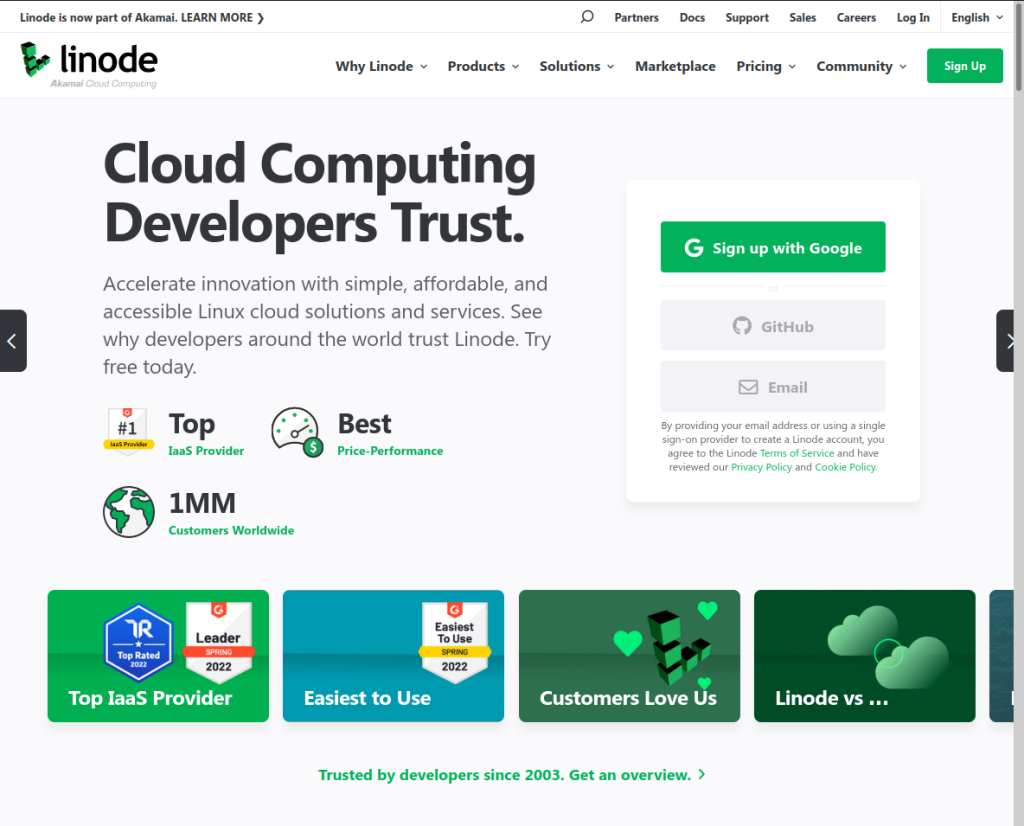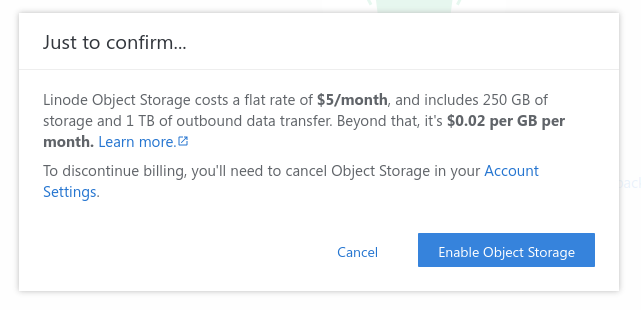Table of Contents
Linode: A Quick Overview
Whoishostingthis.com’s Editor Rating??
Linode Reviews: What Users Say?
What Are the Pros and Cons of Linode?
Linode Hosting Plans and Pricing
Linode Top Five Features
What Are Some Good Alternatives to Linode?
Frequently Asked Questions About Linode
What is Linode?
How I Rated Linode
| Linode standout features | |
| Performance | Setup and teardown of cloud assets is quick and painless. Virtual servers and databases provide performance that appears comparable to AWS. |
| Customer satisfaction | Customer reviews are typically glowing. Linode is explicit in its goal of making its services approachable, and customer reviews speak to its success in that. . |
| Large selection of applications | Linode’s Marketplace offers solutions for a wide variety of use cases, including content publishing, gaming, software development, and online learning. |
| S3 compatible object storage | Like Amazon S3, you can upload and retrieve files, or host a static website. |
| Documentation | A rich selection of guides and tutorials, as well as a customer forum. |

What Are the Pros and Cons of Linode?
Linode is run by a team that believes in making a cloud platform that is the most accessible on the market, and I believe it has been successful. This company’s service is most like Microsoft Azure or AWS, but with a far simpler menu of services and options, keeping it to features that are most useful to medium-sized businesses and smaller ones. Its billing style keeps things plain and obvious as well.
The main weaknesses of this company tend to be the result of its smaller scale. The smaller range of compute instances means fewer opportunities to fine-tune what you use.
Linode also identifies strongly with Linux, and every operating system it offers for your virtual hosts will be some flavor of Linux. Customers looking for Windows, macOS, or a Microsoft SQL database will have to look elsewhere.
Pros of Linode
- Akamai backing: Linode now has access to some of the resources of one of the oldest and most venerable network infrastructure companies in the industry.
- Simplicity: The range of cloud services are straight to the point, and more than sufficient for the vast majority of use cases.
- Documentation: A thorough documentation site and user forums will provide much of the help you might need, although human tech support is also available.
- Full control: When you host your application on Linode, you have complete control over the server.
- Snapshot backups: You can automate routine snapshotting of your server’s operating system and data.
Cons of Linode
- You are the sysadmin: With the full control comes complete responsibility for the server. You will be running the system updates and ensuring backups and disaster recovery exist.
- Prices can be higher: The simplicity usually means narrower selection at a higher premium. And unlike AWS, the billing is mostly not metered; instead, you pay a flat monthly fee. You won’t be able to cut costs by periodically switching off servers or pruning your object storage data.
- Somewhat poorer VPS hardware: A shared-CPU Linode with 4GB RAM showed an AMD CPU model from 2019, while a comparably priced t2.medium EC2 at Amazon ran on an Intel CPU released in 2022. I did not measure a performance difference between the two, but it does seem that Linode may not update its hardware at the same pace as AWS.
- No Windows hosting: Linode only offers Linux-based VPS hosts, so if you prefer Windows, you will need to work with another company. It is possible to side load your own operating system image but you lose its automated snapshotting/backup features.


1. Straightforward Virtual Private Servers
Competing cloud providers have a wide array of specialized hardware configurations, but Linode focuses on a simple menu of general-purpose virtual servers. When it isn’t worth the time and effort sizing to tight specifications, Linode makes it as easy as possible to get up and running.
- Easily managed: I found management of the virtual servers is simple. You have the option of using SSH to log into them, or a web based shell called LISH. If you need to modify networking rules or storage, Linode’s management site keeps all these to a few clicks.
- Scaling possibilities You aren’t stuck with cookie-cutter basics. Linode also makes scaling up approachable. You can add more virtual servers and distribute traffic with a NodeBalancer. Linode also offers Kubernetes clusters, which will let you take three or more Linodes and turn them into a first-class, self-healing platform for any number of services.
- Monitoring Linode’s competitors offer very powerful logging and monitoring tools, but in my experience, Linode’s is one of the simplest to start using. Just turn on a LongView client, install the agent on your server, and data will start coming into your dashboard.

2. A Marketplace of Applications and Community StackScripts
Linode offers two different methods of starting your new VPS with the application of your choice already set up.
- Marketplace Productivity applications like the project management tool FocalBoard, WordPress, and video game servers like Minecraft are all available in Linode’s Marketplace. When you choose one of these, your new Linode comes configured with your chosen application running, and all you need to do is personalize it.
- StackScripts In Linode lingo, a StackScript is just a script that runs when the new VPS first wakes up. You can create and reuse your own, or you can browse the Community StackScripts tab to find scripts others have written. These can be a convenient way to get started with an application that was not already in Marketplace. Creating and saving your own scripts also gives you the ability to make your specific server setups easily repeatable.
3. A developer-riented experience customers rave about
Positive reviews for Linode often cite the ease of using the platform and the affordable, easy-to-understand billing.
Full control over a VPS allows a developer to do just about anything with the server. Linode’s administration and monitoring tools also provide detailed insight to its performance and activity levels.
- Customer support is a strong point, as Linode responds quickly and in great detail. I was also able to access an IRC channel with community members and staff.
4. Object storage compatible with S3
Linode’s Object Storage service is for storing data that spends most of its time at rest, rather than frequently being written and rewritten. You can interact with the data using the same code or utilities that you would use for AWS S3. It can also be used to host static website assets, or even an entire website if you do not need a dynamic backend like WordPress.
- Object Storage pricing begins at $5 per month for the first 250GB, and $0.02 per month for every additional GB.
5. Automated backups
For an additional $2 per month, your VPS can benefit from automated backups. With this turned on, snapshots of your VPS will be taken daily and three of them will be available at any given time: the last daily backup, a two to seven day old backup, and an eight to 14-day old backup.
What Are Some Good Alternatives to Linode?
Frequently Asked Questions About Linode
Who owns Linode?
What kind of support does Linode offer?
Where are the Linode servers located?
What are alternatives to Linode?
How I Rated Linode
I rated Linode by using it for three months on a personal project, and comparing its prices and services to competitors I use during normal work. The services offered by Linode and its competitors are broad and numerous, and often do not neatly overlap, so a comprehensive comparison is not strictly possible. Instead, I focused on the areas most customers are likely to use.
I rated Linode based on features, performance and uptime, plans and pricing, security, and improvements. I feel Linode is not competitive on features or performance and uptime, but excels at pricing, security, and improvements.

